A Practical Guide to the Shwedagon Pagoda in Yangon
This post may contain affiliate links. If you make a purchase using one of these links, I may receive a small reward at no extra cost to you. See my Disclosure Policy for more information.
One structure undisputedly dominates Yangon – the Shwedagon Pagoda.
It’s not an ordinary temple. It’s the heart of Burmese spirituality.
Even if you, like me, have seen your fair share of Buddhist pagodas in Southeast Asia, the Shwedagon is both a sight to behold and a unique mystical place to marvel at.
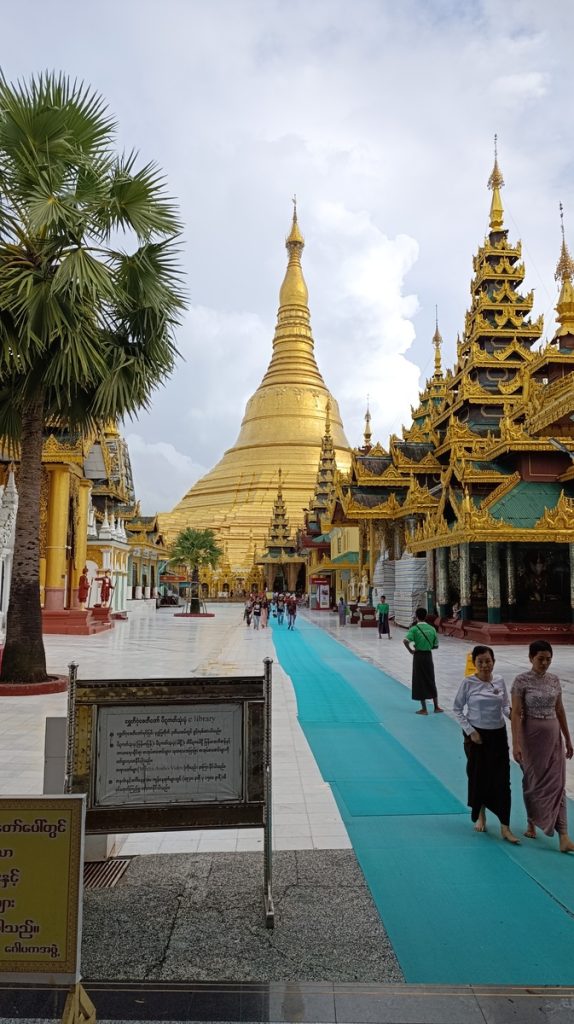
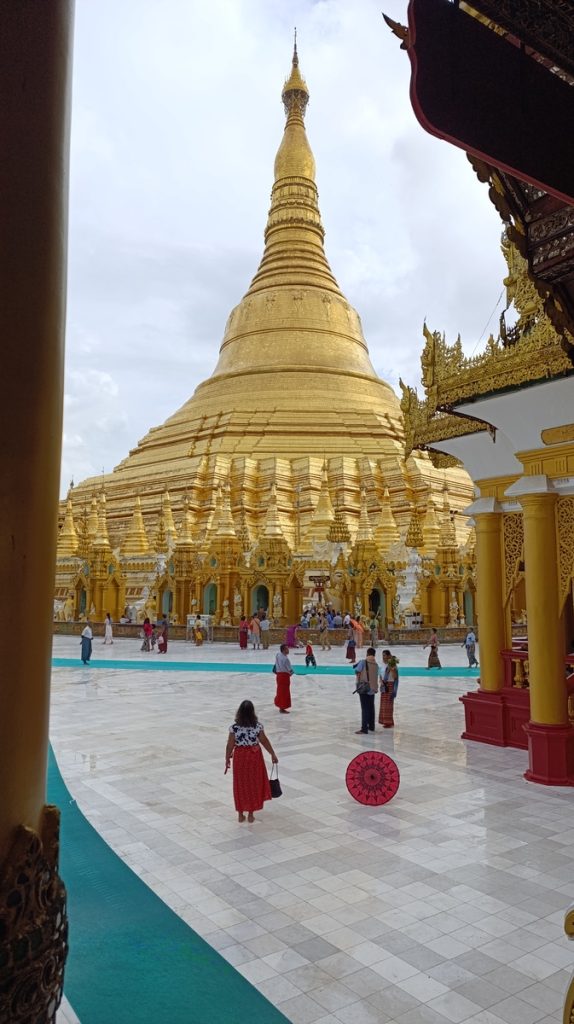
Here’s how to get the most out of your visit and be as amazed as I was.
Quick Logistics
- Open between: 4 AM – 10 PM
- Entrance fee for foreigners: 20.000 MMK (~4 USD at the black market rate)
- Dress code: long pants, shoulders and knees covered, no shoes, no socks. Sarongs can be bought for 5.000 MMK at the entrance.
- Get there: By various public buses (e.g. 11, 77) from Downtown Yangon (400 MMK).
Taxi costs ~5000 MMK. - Enter: The northern entry has an elevator, the western has an escalator; otherwise, enter through whichever you want.
Why is Shwedagon Pagoda so important?
The Shwedagon Pagoda is more than just a religious monument. It is a uniting symbol for all of Myanmar. The centerpiece of Myanmar’s cultural and historical heritage.
Really short history
Historians believe the Shwedagon was built sometime between 6-11 centuries. The popular legend doubles its age to ~2600 years.
As rational as I am, I somewhat believe the legend. The Shwedagon didn’t always look like it does now but in some way, shape, or form, it may have existed as early as 600 BC.
As the story goes, two Burmese brothers ventured east to meet the new Buddha – Siddhartha Gautama. When they reached his abode in modern-day Nepal, they presented him with gifts and he gave them 8 strands of his hair.
Upon returning back to Burma, these hairs ended up enshrined in the Shwedagon Pagoda.
Throughout the years, the Shwedagon has been gilded and regilded, rebuilt and enlarged, surrounded by more and more buildings and stupas, and adorned with gems. Today, the Shwedagon Pagoda is regilded every 5 years with gold voluntarily donated by regular Burmese people. Which is why it literally belongs to the nation.
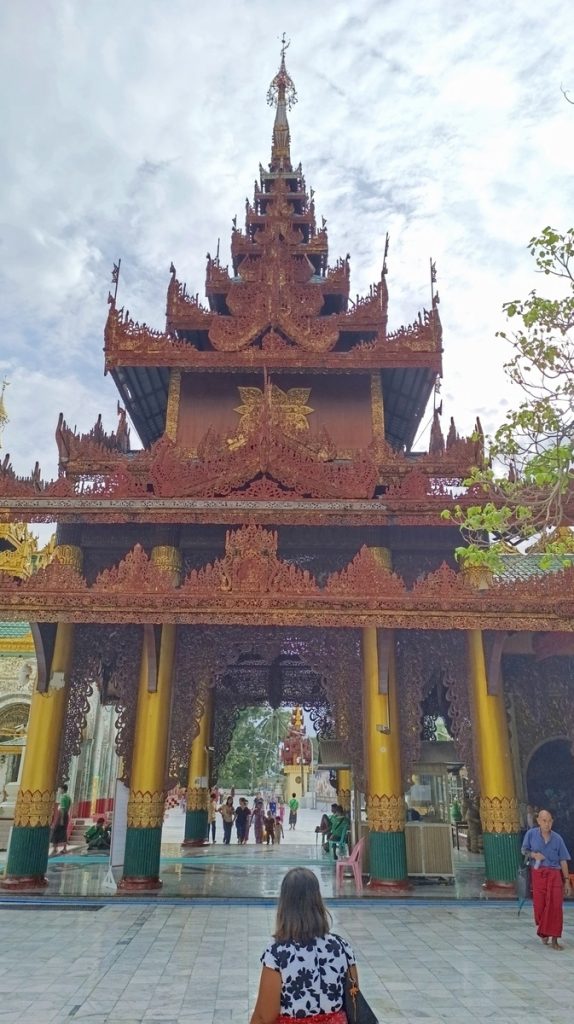
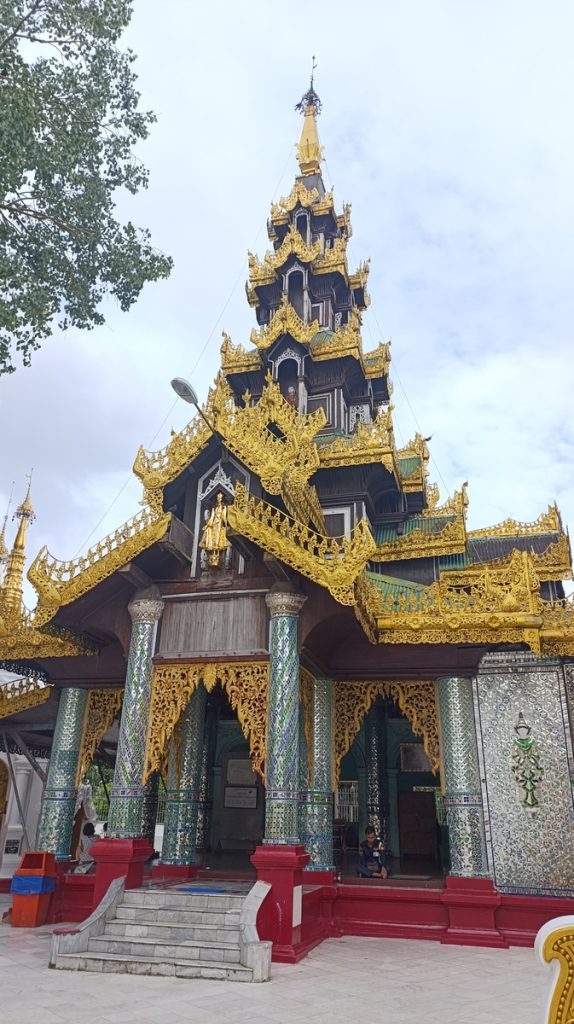
The Shwedagon Pagoda saw many wars, was used as weapon storage, was almost pillaged, was almost destroyed by an earthquake, was almost completely looted but endured all. It has been the site of protests, demonstrations, direct democracy, and the beginning of an important uprising.
It has seen it all. And it’s still there. Isn’t that fascinating?
Architectural Marvel
With additions every so often for over 2600 years, the Shwedagon today has exceptional and stunning architecture.
The central stupa stands about 99 meters tall. It’s covered in pure gold.
How much gold exactly? Nobody knows for sure. Between 9 and 60 tonnes.
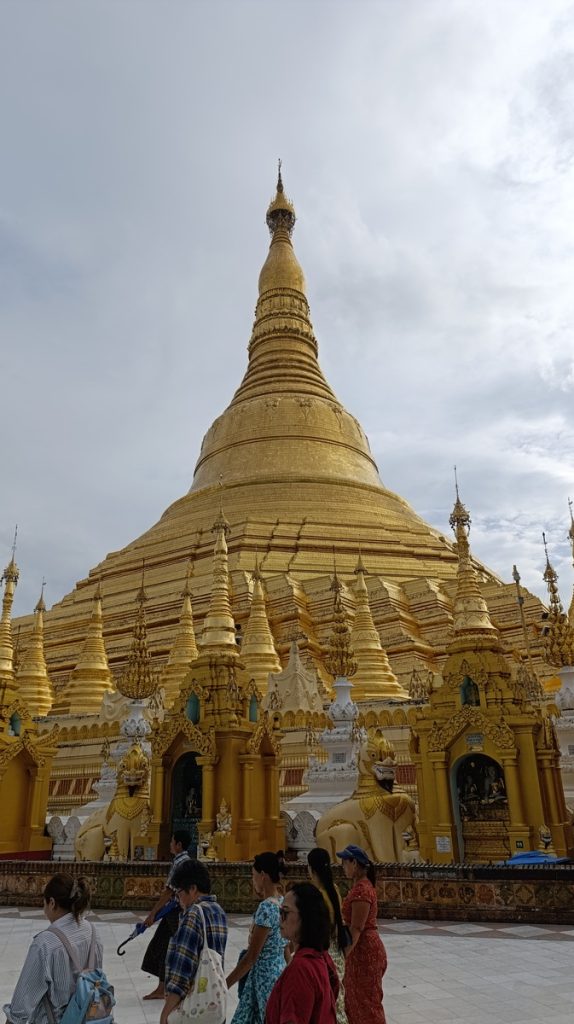
The pagoda’s gleaming surface is an iconic feature of the Yangon skyline.
The umbrella on the top (called “hti”) is adorned with thousands of precious stones – diamonds, rubies, sapphires, etc. You can barely see them from the ground but they are there.
It’s simply amazing.
Law, architecture, and Yangon
Did you know? No building in Yangon can be higher above sea level than 75% of the Shwedagon Pagoda.
Since the pagoda’s top is 170 m above sea level, the law states that no building can be higher than 127 m.
So while there are taller buildings (the tallest being at ~122 m), none is higher than Shwedagon in absolute terms. It is guaranteed to dominate Yangon’s skyline for as long as it (and the law) exists.
Guide Map
The Shwedagon is not a single structure – it’s an entire complex!
Just so you get a grasp of the sheer number of buildings, venerable images, relics, bells, and artifacts at the Shwedagon Pagoda complex, take a look at this map displayed on site.
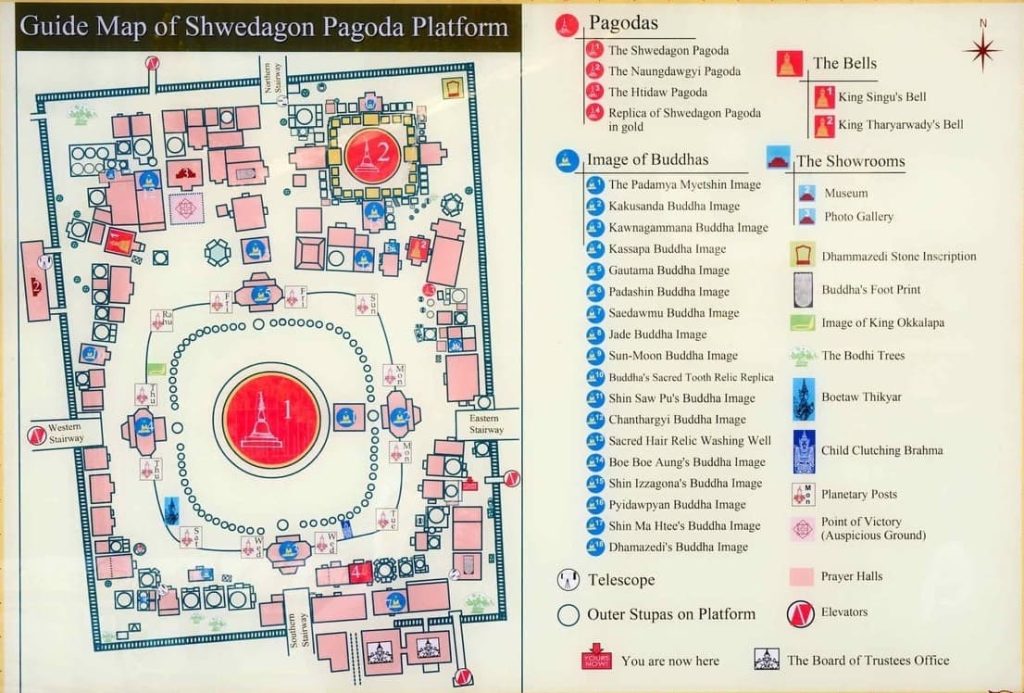
Buddhist Glossary
All the pagodas and stupas used interchangeably is quite confusing. I ain’t an expert though after doing some research, this is the simplest way to summarize the vocabulary you’ll encounter in Myanmar:
| Sanskrit term | Burmese term | Meaning |
|---|---|---|
| Stupa | Zedi | Bell-shaped structures that house sacred relics |
| Pagoda | Phaya | The Zedi + its surroundings |
| Vihara | Kyaung | Buddhist Monastery |
Buddhist Practices
I am no expert in Buddhism and this is by no means an exhaustive error-free list.
One thing I am sure of: there is no worshipping in Buddhism and the Buddha is not a god.
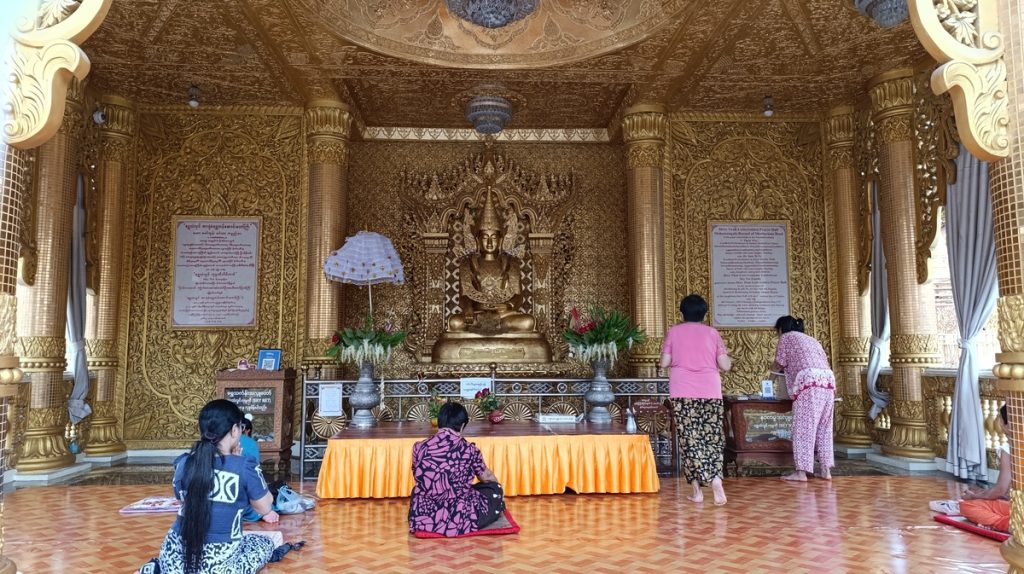
Some Buddhist practices at the Shwedagon Pagoda you may observe or partake in include:
- Circumambulation: It’s standard to walk around the stupas in a clockwise direction. I didn’t know and went the other way but many others were doing the same so it’s not a mandatory thing.
- Offerings: You can buy flowers, candles, or incense from the many stores inside the corridors leading up to the Pagoda. Use them as offerings to the shrines and temples.
- Meditation: There is no ‘worshipping’ but there’s plenty of meditation…
- Prayer and Chanting: …which is often accompanied by chanting of Buddhist scriptures and mantras. Often, Burmese people chant in their ethnic language – my guide said he didn’t understand most of it as it wasn’t in the common Burmese tongue.
- Ring a Bell: In Buddhism, the sound bells make is believed to be Buddha’s voice! If you want to share your happiness, use the blunt wooden cudgel to hit the bell 3 times. Alternatively, in the Giant Buddha room, you may pull a string as many times as however many relatives you have to ring the enormous brass circle behind the Buddha’s head. This will bring each of your relatives prosperity and health.
- Thadingyut Festival: The most sacred date in the Burmese Calendar- the Full Moon day when Buddha descended from the heavens once more. Read more about it here.
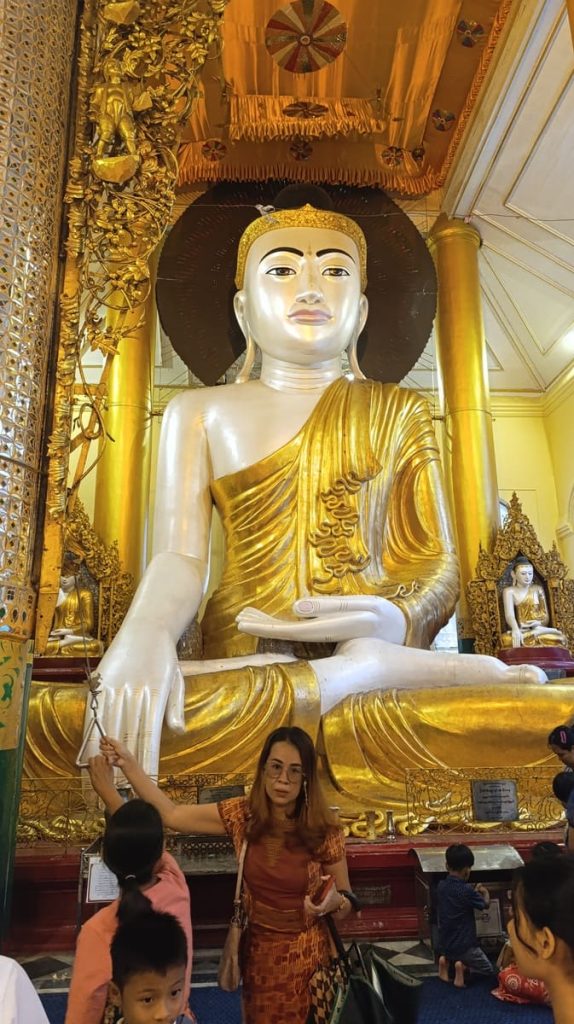

Numerology and Astrology (Burmese Practices)
The Shwedagon is not just a Buddhist pilgrimage site. It has purely Burmese beliefs and practices weaved in as well. Buddhism in Burma is syncretic to its core.
The Burmese have strong beliefs in numerology, astrology, and palmistry. All stuff that’s not based in science, though, I guess, very important in developing a national identity and culture.
Here are some of those practiced at the Shwedagon Pagoda:
- Eight Noble Shrines: The perimeter of the pagoda is divided into 8 sections – 1 for each day of the week while Wednesday features twice – morning and afternoon. Each section has a planet and an astrological figure. You should visit the section that corresponds to the day of the week you were born (and time, if on Wednesday) to perform rituals.
- The Blessing Ritual: Once at your shrine (you may have to call your mother to ask what time you were born if it was Wednesday), you should present offerings and pour water over the image. The number of times you pour is your age + 1.
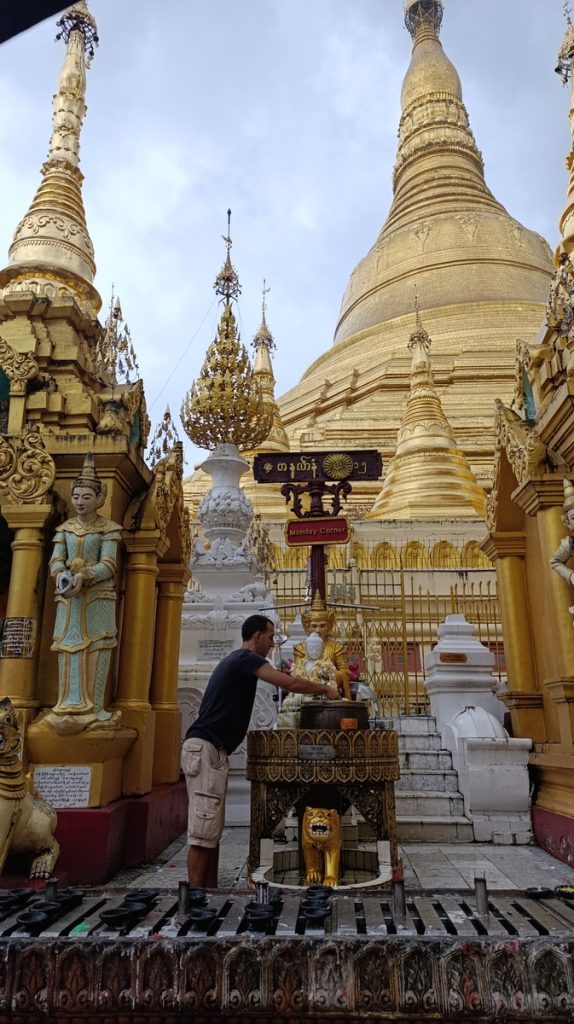
There are likely more symbolic rituals and numerological beliefs but I am not aware. The occult is oftentimes only passed from mouth to mouth.
Is the Shwedagon Pagoda a Tourist Trap?
No, not at all.
Even though there were barely any other foreigners around, the place was teeming with locals. It’s a highly spiritual place with a lot of symbolism.
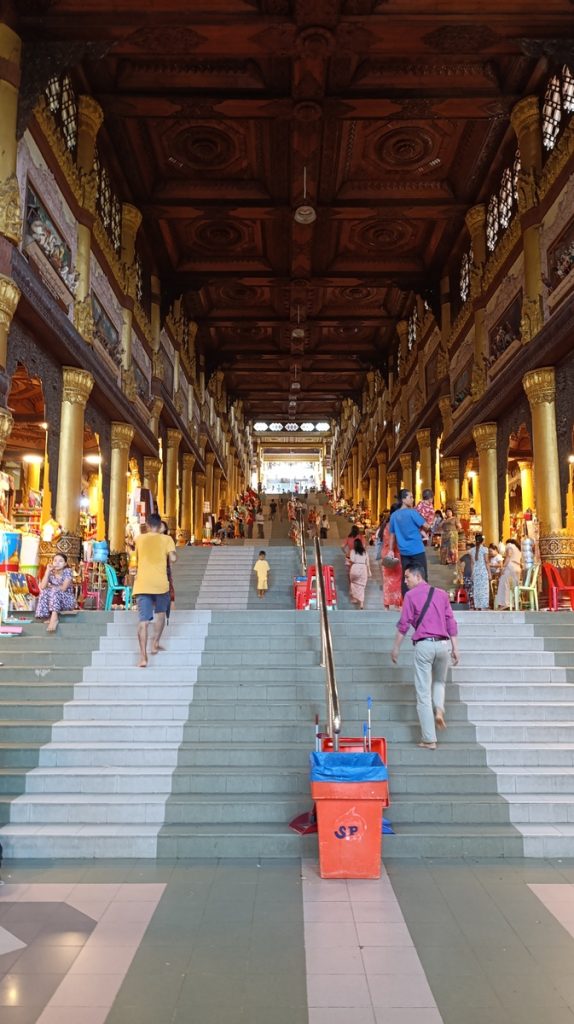
Do you need a guide to visit Shwedagon?
No. Well, maybe. Perhaps it’s better if you actually have one.
See, it’s easy to mistake Shwedagon for just another Buddhist Pagoda in the endless array of such in Southeast Asia.
It’s so much more.
Shwedagon is living history. It breathes with the people of Myanmar. It was created by them, is being maintained by them, and serves as a spiritual home for all.
Moreover, there are so many fine details you will certainly miss if you walk around by yourself. And who better to explain all the rituals and customs than a local guide?
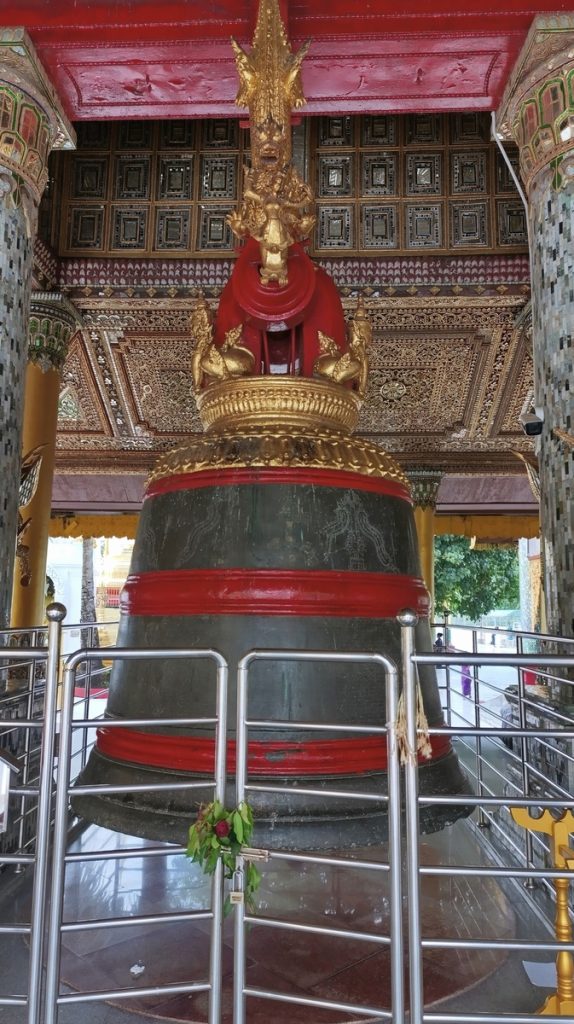
I usually visit places without a guide. I read extensively about the place online before I go and fill in the holes in my knowledge afterwards by researching the things I have found interesting.
Yet, when a local Burmese teacher gave us an impromptu tour of Shwedagon Pagoda, I learned so many new things.
You can either find locals online (this Facebook group is a good place) beforehand and arrange to meet at Shwedagon or strike up a conversation with people there like we did.
How to get to Shwedagon Pagoda from Downtown Yangon
There are effectively 3 ways to do that:
- Walk. Shwedagon is only 3 km from Chinatown. This will allow you to see more of Yangon’s eclectic architecture.
- Take the bus. Public transport in Yangon is complicated if you don’t know Burmese so it’s best to ask a local for directions. Many of the buses that stop at Sule Pagoda also stop within walking distance of Shwedagon. Tickets are 400 MMK – put the money in the box next to the driver as you enter.
- Take a taxi. Either one of the hundreds of independent ones on the streets or just book through Grab. The 15-minute ride from Downtown Yangon costs around 5000 MMK.
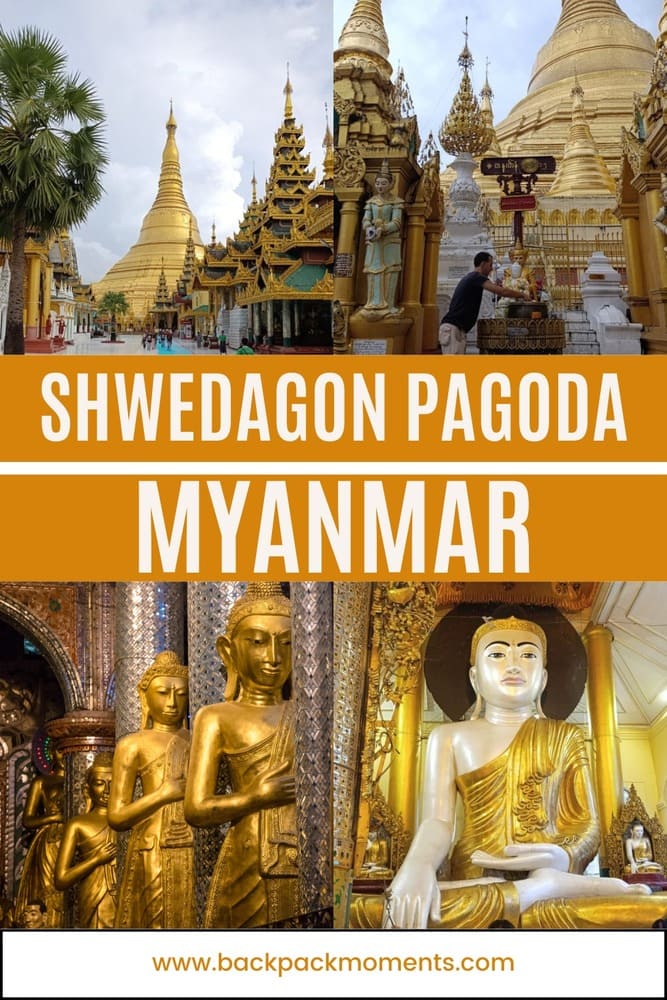


Simon, amazinggggg!!
big thanks!!